Noble Guardians: Navigating Life's Adventures with Pekingese
Introduction
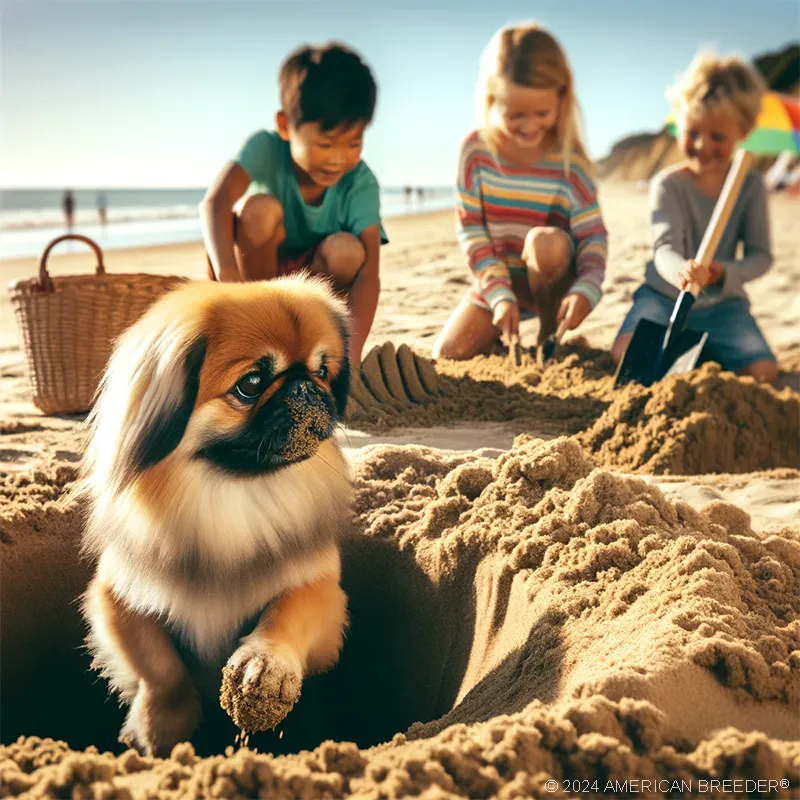 Welcome to the world of the Pekingese, a breed steeped in history and brimming with unique characteristics that set them apart. Often referred to as "Lion Dogs," Pekingese dogs possess a regal demeanor that belies their small stature. These delightful companions have captivated hearts for centuries, earning their place as cherished companions and esteemed members of families around the world.
Welcome to the world of the Pekingese, a breed steeped in history and brimming with unique characteristics that set them apart. Often referred to as "Lion Dogs," Pekingese dogs possess a regal demeanor that belies their small stature. These delightful companions have captivated hearts for centuries, earning their place as cherished companions and esteemed members of families around the world.
As we embark on this journey, it's essential to understand that the Pekingese is more than a mere pet—it's a living testament to the rich tapestry of canine history. Our exploration will delve into their origins, uncover their intriguing quirks, and provide invaluable insights into their care and well-being. Whether you're a seasoned dog owner or a newcomer to the world of canine companionship, this guide promises to be an enlightening and enriching experience.
Join us as we uncover the layers of the Pekingese's identity, from their storied past as imperial companions to their modern-day roles as cherished family members. As you immerse yourself in each chapter, you'll gain a deep appreciation for the nuances that make the Pekingese a breed unlike any other.
Considerations Before Choosing a Pekingese
Selecting a Pekingese as a lifelong companion is a decision that warrants careful consideration. While their undeniable charm and captivating presence are alluring, it's essential to weigh the responsibilities and commitments that come with Pekingese ownership. These dogs thrive on human interaction and companionship, requiring dedicated attention and affection to ensure their happiness.
When choosing a Pekingese, it's crucial to assess your living situation and lifestyle. These dogs adapt well to apartment living, but they also enjoy outdoor activities and exploring new environments. Be prepared for regular grooming sessions to maintain their exquisite coat, and consider their potential for interacting with other pets and family members.
 The Pekingese's regal appearance is matched by their strong-willed nature. Training and socialization are imperative to ensure a well-mannered and well-adjusted companion. Remember, bringing a Pekingese into your life is a lifelong commitment that demands patience, care, and a genuine love for these remarkable dogs.
The Pekingese's regal appearance is matched by their strong-willed nature. Training and socialization are imperative to ensure a well-mannered and well-adjusted companion. Remember, bringing a Pekingese into your life is a lifelong commitment that demands patience, care, and a genuine love for these remarkable dogs.
Fascinating Facts
Dive into the realm of Pekingese trivia and uncover a wealth of fascinating facts that showcase the breed's distinctive qualities. Beyond their iconic appearance, the Pekingese's history and behaviors provide a captivating glimpse into their unique character. Other names for the Pekingese, such as "Fu Lion Dog" and "Pelchie Dog," hint at their role as symbols of ancient Chinese nobility. Their distinctive appearance, resembling the lion—a revered symbol of strength and majesty—earned them a place of honor within Chinese palaces.
Nicknames such as "Peke" or "Pekes" affectionately capture the essence of these dogs' charm. These endearing monikers reflect their companionship, loyalty, and the intimate bond they share with their owners. Peel back the layers of Pekingese nomenclature, and you'll discover a breed that's intricately woven into cultural history and cherished by dog lovers worldwide.
Origin and Development
Delve into the historical origins of the Pekingese, a breed that boasts a lineage intertwined with Chinese royalty and tradition. With roots dating back over a thousand years, these dogs have a storied past that reflects their role as companions to emperors and noble families. The Pekingese's ancestral home lies in ancient China, where they were revered as symbols of good fortune and guardian spirits. Bred within the walls of the imperial palace, their existence was a closely guarded secret, and they were often bestowed as precious gifts to foreign dignitaries.
 Historical artifacts, including intricate sculptures and paintings, provide glimpses into the Pekingese's revered status within the royal court. Their lion-like appearance, with a flowing mane and distinctive gait, further solidified their association with strength and nobility. As we journey through their history, we'll uncover the Pekingese's transformation from regal protectors to beloved companions, leaving an indelible mark on the tapestry of canine heritage.
Historical artifacts, including intricate sculptures and paintings, provide glimpses into the Pekingese's revered status within the royal court. Their lion-like appearance, with a flowing mane and distinctive gait, further solidified their association with strength and nobility. As we journey through their history, we'll uncover the Pekingese's transformation from regal protectors to beloved companions, leaving an indelible mark on the tapestry of canine heritage.
Purpose and Original Use
Behind the Pekingese's elegant façade lies a breed that once held a vital role as guardians and companions to Chinese nobility. Their purpose within the imperial court extended beyond mere companionship, encompassing duties that showcased their loyalty and devotion. Originating in ancient China, Pekingese dogs were bred to embody the revered lion, a symbol of strength and courage. Their role as watchdogs was taken seriously, as they patrolled palace grounds and alertly sounded alarms in the presence of potential threats.
As loyal companions, Pekingese dogs brought joy to emperors and their families, offering unwavering devotion and companionship. Their endearing nature and unique appearance endeared them to the hearts of royalty, making them cherished members of the imperial court. While modern Pekingese may not engage in the same ceremonial roles, their legacy as guardians and beloved companions lives on, showcasing their timeless appeal and enduring significance.
Classification of the Pekingese
The world of dog breeds is meticulously organized, and the Pekingese holds a place of distinction within various kennel clubs. These classifications not only highlight their unique attributes but also offer a platform for breed enthusiasts to come together and celebrate their shared passion. Kennel clubs, such as the American Kennel Club (AKC) and The Kennel Club (UK), recognize the Pekingese as a breed of distinction. Their classification places them in the Toy Group, a category that celebrates their small size, charming demeanor, and historical significance.
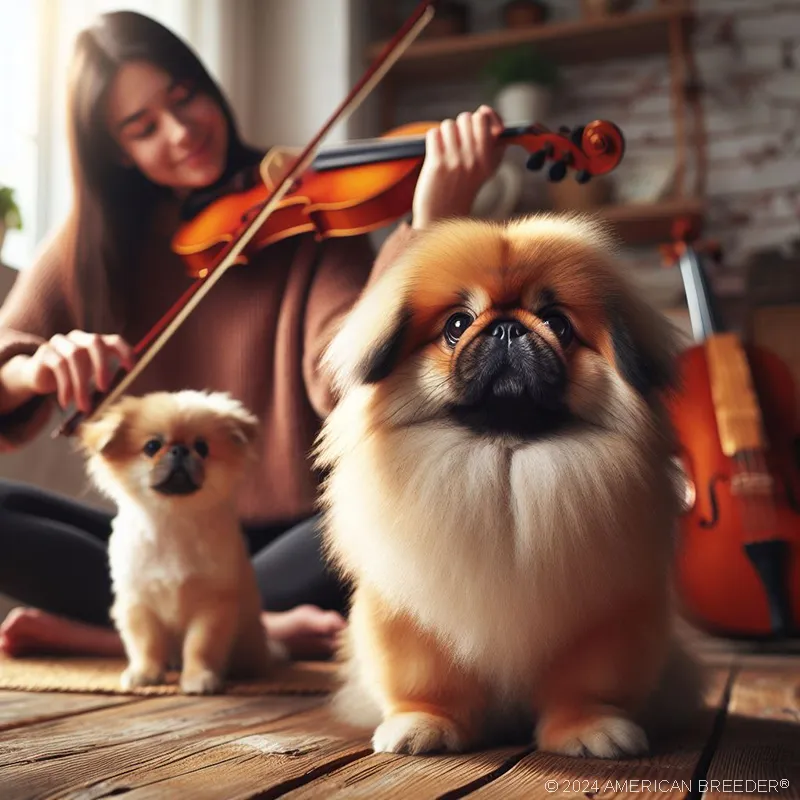 Within these kennel clubs, the Pekingese is meticulously evaluated according to breed standards that encompass their appearance, temperament, and structure. These standards serve as a benchmark for breeders, ensuring that Pekingese dogs retain their unique qualities and conform to the breed's iconic image. Participation in breed-specific events, such as conformation shows, allows Pekingese enthusiasts to showcase their dogs' attributes and compete on a global stage. This recognition and classification within kennel clubs underscore the Pekingese's enduring appeal and esteemed position within the world of purebred dogs
Within these kennel clubs, the Pekingese is meticulously evaluated according to breed standards that encompass their appearance, temperament, and structure. These standards serve as a benchmark for breeders, ensuring that Pekingese dogs retain their unique qualities and conform to the breed's iconic image. Participation in breed-specific events, such as conformation shows, allows Pekingese enthusiasts to showcase their dogs' attributes and compete on a global stage. This recognition and classification within kennel clubs underscore the Pekingese's enduring appeal and esteemed position within the world of purebred dogs
Pekingese's Distinct Appearance
The Pekingese's appearance is a testament to their regal heritage and unique genetic makeup. Their small size, lion-like mane, and distinctive features make them instantly recognizable and utterly captivating. Size-wise, Pekingese dogs fall into the small category, typically weighing between 7 to 14 pounds and standing about 6 to 9 inches tall at the shoulder. Despite their diminutive stature, they possess a sturdy build that exudes confidence.
One of their most striking features is their luxurious coat, which comes in a variety of colors and patterns. From solid black to fawn, red, cream, and even parti-color combinations, Pekingese coats are a canvas of diversity. Their abundant double coat is long, straight, and dense, creating an aura of elegance that befits their regal lineage.
Distinctive features, such as their flat face and large, dark eyes, give them an expressive appearance that melts hearts. The "spectacle" markings around their eyes further emphasize their endearing gaze. Their short muzzle, known as a "peke face," contributes to their unique breathing patterns, and their tail, plumed and carried over their back, adds to their majestic presence.
Temperament and Behavior Traits
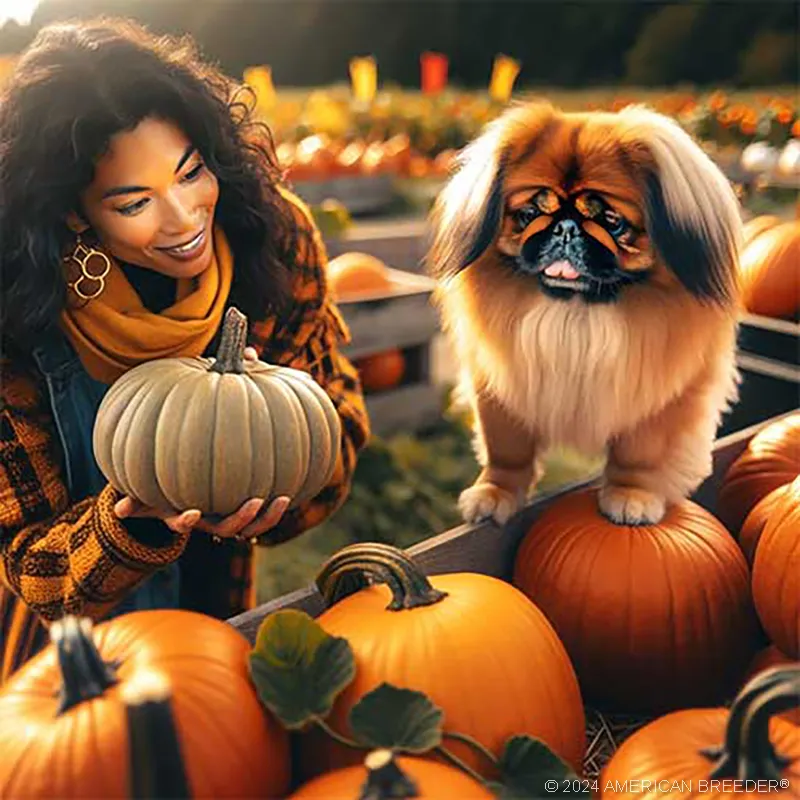 Delve into the intricate world of the Pekingese's temperament, a mosaic of traits that reflect their individuality and loyalty. Their personality is a fusion of regal confidence, independence, and an unwavering devotion to their families. While Pekingese dogs are known for their dignified and sometimes aloof demeanor, they are also incredibly affectionate and thrive on human companionship. Their loyalty knows no bounds, and they form deep bonds with their owners, often becoming one-person dogs.
Delve into the intricate world of the Pekingese's temperament, a mosaic of traits that reflect their individuality and loyalty. Their personality is a fusion of regal confidence, independence, and an unwavering devotion to their families. While Pekingese dogs are known for their dignified and sometimes aloof demeanor, they are also incredibly affectionate and thrive on human companionship. Their loyalty knows no bounds, and they form deep bonds with their owners, often becoming one-person dogs.
Energy levels vary within the breed, with some Pekingese enjoying a more relaxed lifestyle and others showing bursts of playful energy. Their strong-willed nature can make training a unique experience; patience and positive reinforcement techniques work best. It's worth noting that Pekingese dogs have a tendency to develop a strong protective instinct towards their family. This can manifest as wariness towards strangers, making early socialization crucial. While their regal bearing might imply aloofness, they are also known to be remarkably entertaining and amusing companions.
Nurturing Your Pekingese's Well-Being
Caring for a Pekingese encompasses a holistic approach that covers their physical, emotional, and mental well-being. With their distinctive characteristics and unique needs, understanding their care requirements is essential for providing them with a happy and healthy life. Grooming plays a central role in Pekingese care due to their abundant coat. Regular brushing is necessary to prevent matting and maintain their lustrous appearance. Bathing should be done as needed, and careful attention to their facial folds and ears helps prevent skin irritations.
Exercise is important for maintaining their health and preventing obesity, but it should be adapted to their energy levels. Daily walks and indoor playtime provide physical stimulation, while mental enrichment activities like puzzle toys challenge their intelligence.
Nutrition is a cornerstone of their well-being, and a balanced diet tailored to their age, size, and activity level is crucial. Regular veterinary check-ups ensure early detection of potential health issues, and vaccinations, flea prevention, and dental care are vital components of their overall care.
Health and Wellness
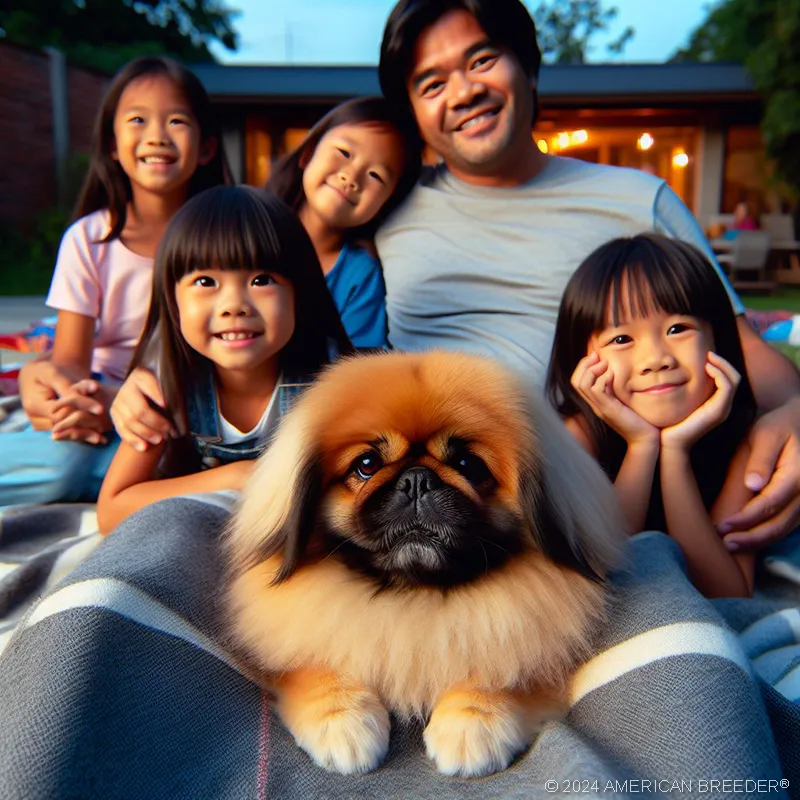 Understanding the unique health considerations of the Pekingese is essential for providing them with a long and healthy life. While they are generally a hardy breed, their distinctive anatomy and genetics predispose them to certain conditions. Common health issues that Pekingese dogs may face include respiratory problems due to their flat faces, eye conditions like corneal ulcers and entropion, and musculoskeletal concerns such as patellar luxation. Regular veterinary check-ups and preventive care are key to detecting and managing these conditions early.
Understanding the unique health considerations of the Pekingese is essential for providing them with a long and healthy life. While they are generally a hardy breed, their distinctive anatomy and genetics predispose them to certain conditions. Common health issues that Pekingese dogs may face include respiratory problems due to their flat faces, eye conditions like corneal ulcers and entropion, and musculoskeletal concerns such as patellar luxation. Regular veterinary check-ups and preventive care are key to detecting and managing these conditions early.
Allergies can also affect Pekingese dogs, leading to skin issues and discomfort. Proper grooming, a healthy diet, and environmental management can help alleviate allergy symptoms. Maintaining a healthy weight is crucial for their well-being, as excess weight can exacerbate joint issues and respiratory difficulties. Providing a balanced diet and engaging in regular exercise tailored to their needs can help prevent obesity and promote overall fitness.
Socialization and Companionship
The Pekingese's strong bond with their family makes socialization an integral part of their upbringing. Early exposure to various people, pets, and environments is key to ensuring they develop into well-adjusted companions. Interaction with children should be supervised, as Pekingese dogs have a delicate build and may not tolerate rough handling. Teaching children to treat them gently and with respect fosters positive relationships.
Introducing your Pekingese to other pets should be gradual and positive. Their strong protective instincts might cause initial wariness, but with proper introductions, they can learn to coexist harmoniously.
While their loyalty to their owners is unwavering, Pekingese dogs might be reserved or cautious around strangers. Proper socialization from a young age can help mitigate any potential fear or aggression towards unfamiliar faces.
Training and Intelligence
Training a Pekingese requires patience, consistency, and positive reinforcement techniques. Their strong-willed nature can make them appear stubborn, but beneath that facade lies an intelligent and capable learner. The Pekingese's intelligence shines through in their problem-solving abilities. They enjoy mental challenges, and incorporating puzzle toys and interactive games into their routine can keep their minds engaged and prevent boredom.
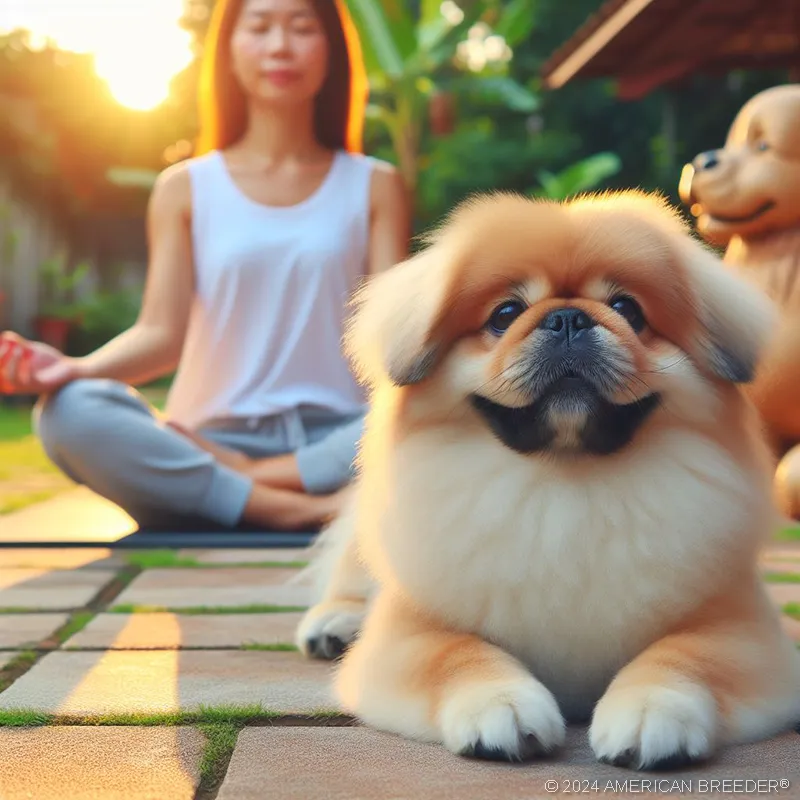 Early training and socialization are crucial to managing their protective instincts and ensuring they interact appropriately with people and other pets. Positive training methods that involve rewards and praise work best with their sensitive nature. Keep in mind that while Pekingese dogs are intelligent, they may not always be motivated solely by pleasing their owners. Their independence means they might choose their own path, so training sessions should be engaging and enjoyable for both you and your Pekingese.
Early training and socialization are crucial to managing their protective instincts and ensuring they interact appropriately with people and other pets. Positive training methods that involve rewards and praise work best with their sensitive nature. Keep in mind that while Pekingese dogs are intelligent, they may not always be motivated solely by pleasing their owners. Their independence means they might choose their own path, so training sessions should be engaging and enjoyable for both you and your Pekingese.
Living Arrangements and Ideal Environment
Adaptable to various living arrangements, Pekingese dogs can thrive in apartments, houses, and even rural settings. Their small size and moderate exercise requirements make them suitable for urban living, provided they receive regular walks and indoor playtime. In apartment living, be sure to provide them with a cozy space to rest and a designated area for indoor play and potty breaks. Regular walks and mental enrichment activities are essential to prevent them from feeling cooped up.
For house dwellers, ensure that your home is safe and free from hazards such as toxic plants, small objects that could be swallowed, and inaccessible areas. A securely fenced yard offers them the opportunity to explore safely and engage in supervised outdoor play.
Pekingese dogs can adapt to different climates, but extreme temperatures should be avoided. Their short muzzle can make them prone to overheating, so provide shade and keep them hydrated in warmer weather. In colder climates, protect them from harsh elements with appropriate
Pekingese in Your Family
Welcoming a Pekingese into your family is a decision that comes with boundless rewards and responsibilities. Their unique blend of loyalty, affection, and distinctive behaviors adds a touch of enchantment to your household dynamics. Pekingese dogs have a special affinity for children, forming strong bonds with younger family members. However, supervision is essential to ensure that interactions are gentle and respectful, considering their delicate size and potential for injury.
 Family bonding activities can be a delightful way to strengthen your connection with your Pekingese. Whether it's a leisurely stroll in the park, a game of fetch, or even cuddle sessions on the couch, these moments contribute to their happiness and your own. Seniors and individuals with disabilities also find companionship in the Pekingese's gentle presence. Their adaptability to different lifestyles makes them suitable companions for those seeking a steadfast friend and loyal companion, regardless of age or physical ability.
Family bonding activities can be a delightful way to strengthen your connection with your Pekingese. Whether it's a leisurely stroll in the park, a game of fetch, or even cuddle sessions on the couch, these moments contribute to their happiness and your own. Seniors and individuals with disabilities also find companionship in the Pekingese's gentle presence. Their adaptability to different lifestyles makes them suitable companions for those seeking a steadfast friend and loyal companion, regardless of age or physical ability.
Traveling and Outings
The prospect of travel and outings with your Pekingese can be both exciting and daunting. With proper preparation and consideration of their needs, you can ensure that your furry friend enjoys these experiences as much as you do. Traveling with your Pekingese requires careful planning. Invest in a comfortable and secure travel crate that provides them with a safe space during journeys. Ensure that they have access to water, and consider feeding them a few hours before travel to prevent motion sickness.
Pet-friendly accommodations are a must when traveling with your Pekingese. Many hotels and lodging options now cater to canine companions, making it easier to find suitable accommodations that welcome your four-legged family member. When venturing outdoors, remember that Pekingese dogs are susceptible to extreme weather conditions. In hot weather, avoid strenuous activities during peak heat hours and provide plenty of water and shade. In colder weather, ensure they are dressed warmly and limit their exposure to chilly temperatures.
Role in Specialized Training
Beyond being cherished companions, Pekingese dogs have proven themselves in specialized roles that underscore their intelligence and versatility. Their distinctive qualities make them ideal candidates for therapy and service roles, enriching the lives of those in need.
Therapy dogs offer emotional support and comfort in various settings, from hospitals to schools. The Pekingese's gentle nature and soothing presence make them excellent candidates for providing companionship to individuals facing physical or emotional challenges.
Service dogs, on the other hand, perform specific tasks to assist individuals with disabilities. While their small size might seem incongruous with this role, Pekingese dogs have successfully demonstrated their ability to support individuals with mobility or sensory impairments.
Training a Pekingese for specialized roles requires patience, dedication, and professional guidance. Certification and qualifications vary based on the specific role, and successful stories of Pekingese excelling in these roles highlight their extraordinary capacity to make a positive impact on people's lives.
Heartwarming Stories and Testimonials
 The Pekingese's influence extends far beyond their charming appearance and endearing traits. Their presence has left an indelible mark on the lives of countless individuals, resulting in heartwarming stories and testimonials that showcase the depth of their impact.
The Pekingese's influence extends far beyond their charming appearance and endearing traits. Their presence has left an indelible mark on the lives of countless individuals, resulting in heartwarming stories and testimonials that showcase the depth of their impact.
Owners share anecdotes of Pekingese dogs intuitively offering comfort during times of distress, proving that their loyalty goes beyond mere companionship. These stories serve as a reminder of the deep emotional connections that form between Pekingese and their families.
Training successes are celebrated as testaments to the breed's intelligence and the rewards of patient, positive reinforcement techniques. Tales of Pekingese dogs mastering new skills, overcoming behavioral challenges, and adapting to new environments offer inspiration to fellow owners. Through these stories and testimonials, the Pekingese's role as a steadfast, devoted companion is illuminated, underscoring the unique bonds they forge with their families and the remarkable journey they embark upon together.
Summary
As we conclude this comprehensive guide to the Pekingese, we reflect on the journey we've taken through their history, characteristics, care, and significance. This guide has explored every facet of the Pekingese's identity, offering a wealth of insights for both novice and experienced dog enthusiasts.
From their majestic appearance and lion-like mane to their loyal companionship and intelligent nature, the Pekingese has truly earned its place as a cherished breed. By understanding their origins, needs, and unique qualities, you're equipped to provide them with the care, attention, and love they deserve.
Conclusion: Embracing the Pekingese's Endearing Legacy
 As we draw the curtains on this comprehensive guide, we find ourselves in awe of the intricate tapestry that makes up the Pekingese's identity. From their regal history to their endearing quirks, every facet of their being has been meticulously examined to provide you with a deep understanding of this remarkable breed.
As we draw the curtains on this comprehensive guide, we find ourselves in awe of the intricate tapestry that makes up the Pekingese's identity. From their regal history to their endearing quirks, every facet of their being has been meticulously examined to provide you with a deep understanding of this remarkable breed.
The Pekingese's journey from imperial courts to cherished households is a testament to their timeless appeal. Their distinctive appearance, loyal nature, and captivating personality have enchanted hearts across cultures and generations. This guide has aimed to capture the essence of their charm and equip you with the knowledge to be a devoted guardian of their well-being.
While our exploration has covered a vast expanse of Pekingese attributes, it's essential to remember that each individual dog is a unique being, ready to forge a one-of-a-kind connection with their human companions. The experiences you share, the bonds you form, and the memories you create are the threads that weave the fabric of your life with your Pekingese.
As you embark on this journey, embrace the joys, challenges, and adventures that come with Pekingese ownership. From their regal presence to their unwavering loyalty, they enrich our lives in ways that words can scarcely capture. Cherish every moment, every wag of their tail, and every paw-print they leave on your heart.
In the grand tapestry of life, the Pekingese's presence is a vibrant thread that adds color, warmth, and immeasurable love. May your journey with your Pekingese be a symphony of shared experiences, unbreakable bonds, and a lifetime of treasured memories. Thank you for allowing us to guide you through the captivating world of the Pekingese.
Pekingese Dog Quick Reference Guide
Breed Background: Origin: China | Breed Purpose: Companion | AKC Class: Toy Group | Year Recognized by AKC: 1906 Appearance: Size: Small | Weight: 7-14 lbs | Coat Type: Long, flowing double coat | Colors & Patterns: Various colors, including gold, red, black, and more | Distinctive Features: Flat face, lion-like mane, curled tail
Appearance: Size: Small | Weight: 7-14 lbs | Coat Type: Long, flowing double coat | Colors & Patterns: Various colors, including gold, red, black, and more | Distinctive Features: Flat face, lion-like mane, curled tail
Temperament: Energy Level: 2/5 | Loyalty: 5/5 | Friendliness to Pets: 3/5 | Friendliness to Strangers: 2/5 | Trainability: 3/5 | Playfulness: 3/5 | Frequent Barker: 3/5 | Chase Instincts: 2/5 | Sense of Smell: 2/5 | Drive to Hunt: 1/5
Health & Care: Health Issues: Brachycephalic syndrome, eye problems | Lifespan: 12-14 years | Grooming Difficulty: 4/5 | Exercise Needs: Low
Socialization: Interaction with Children: Cautious, better with older children | Interaction with Pets: Can be selective | Interaction with Strangers: Reserved | Elderly Compatibility: Excellent | Ease of Training: Moderate
Suitable Living Arrangements: Apartment: Yes | House: Yes | Rural Area: No | Yard Size Requirements: Small space sufficient
Training & Obedience: Trainability: 3/5 | Intelligence: 4/5 | Obedience: 3/5 | Problem-Solving: 3/5 | Easily Stimulated: 2/5 | Focus Level: 3/5 | Easily Distracted: 2/5
Financial Planning: Typical Price Range: $600 - $2500 | Initial Expenses: Moderate (bed, crate, vaccinations) | Ongoing Annual Expenses: Moderate (food, grooming, veterinary care)
Breeding: Reproductive Maturity: 8-10 months | Litter Frequency: 1-2 litters per year | Litter Size: 2-6 puppies | Stud Cost: Varies widely | Breeding Challenges: Small litters, birthing difficulties
Did You Enjoy this Article? Share it and Help Us Spread the Word!
If you found this article helpful, we'd appreciate it if you could share it with your friends or link to it from your website, blog, or group! You can also use the convenient social share tabs on the left side of the screen to instantly share this page to your social media feed. For more ways to support and promote the American Breeder Community, visit our Share & Promote Together page for social media posts and memes you can copy and share. Your support means the world to us!
Disclaimer: The information provided in this article is for general informational purposes only and does not constitute legal, medical, financial, or professional advice. While we strive for accuracy, we make no representations or warranties regarding the completeness, accuracy, reliability, or suitability of the information. Please consult with a professional before making decisions based on the content provided. American Breeder Inc. assumes no responsibility for any errors or omissions or for the results obtained from the use of this information.
